Intel 11th Generation Core Tiger Lake-H Performance Review: Fast and Power Hungry
by Brett Howse & Andrei Frumusanu on May 17, 2021 9:00 AM EST- Posted in
- CPUs
- Intel
- 10nm
- Willow Cove
- SuperFin
- 11th Gen
- Tiger Lake-H
CPU Tests: Legacy and Web
In order to gather data to compare with older benchmarks, we are still keeping a number of tests under our ‘legacy’ section. This includes all the former major versions of CineBench (R15, R11.5, R10) as well as x264 HD 3.0 and the first very naïve version of 3DPM v2.1. We won’t be transferring the data over from the old testing into Bench, otherwise it would be populated with 200 CPUs with only one data point, so it will fill up as we test more CPUs like the others.
The other section here is our web tests.
Web Tests: Kraken, Octane, and Speedometer
Benchmarking using web tools is always a bit difficult. Browsers change almost daily, and the way the web is used changes even quicker. While there is some scope for advanced computational based benchmarks, most users care about responsiveness, which requires a strong back-end to work quickly to provide on the front-end. The benchmarks we chose for our web tests are essentially industry standards – at least once upon a time.
It should be noted that for each test, the browser is closed and re-opened a new with a fresh cache. We use a fixed Chromium version for our tests with the update capabilities removed to ensure consistency.
Mozilla Kraken 1.1
Kraken is a 2010 benchmark from Mozilla and does a series of JavaScript tests. These tests are a little more involved than previous tests, looking at artificial intelligence, audio manipulation, image manipulation, json parsing, and cryptographic functions. The benchmark starts with an initial download of data for the audio and imaging, and then runs through 10 times giving a timed result.
We loop through the 10-run test four times (so that’s a total of 40 runs), and average the four end-results. The result is given as time to complete the test, and we’re reaching a slow asymptotic limit with regards the highest IPC processors.
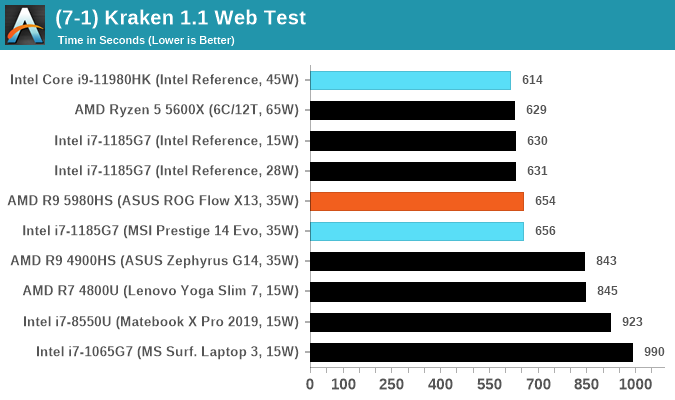
Google Octane 2.0
Our second test is also JavaScript based, but uses a lot more variation of newer JS techniques, such as object-oriented programming, kernel simulation, object creation/destruction, garbage collection, array manipulations, compiler latency and code execution.
Octane was developed after the discontinuation of other tests, with the goal of being more web-like than previous tests. It has been a popular benchmark, making it an obvious target for optimizations in the JavaScript engines. Ultimately it was retired in early 2017 due to this, although it is still widely used as a tool to determine general CPU performance in a number of web tasks.
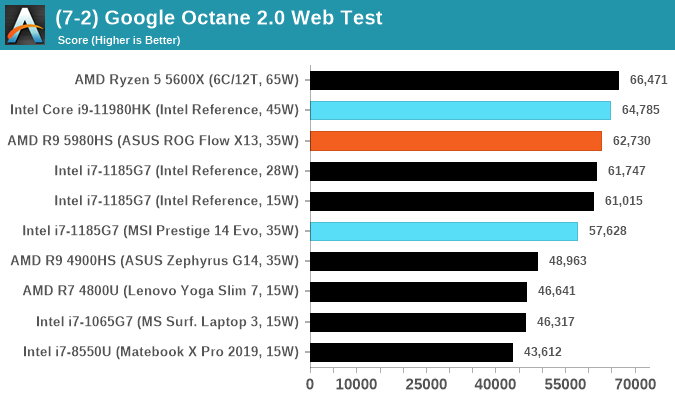
Speedometer 2: JavaScript Frameworks
Our newest web test is Speedometer 2, which is a test over a series of JavaScript frameworks to do three simple things: built a list, enable each item in the list, and remove the list. All the frameworks implement the same visual cues, but obviously apply them from different coding angles.
Our test goes through the list of frameworks, and produces a final score indicative of ‘rpm’, one of the benchmarks internal metrics.
We repeat over the benchmark for a dozen loops, taking the average of the last five.
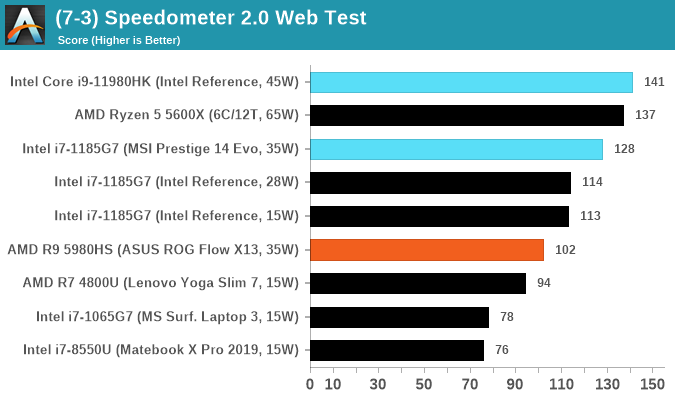
Legacy Tests

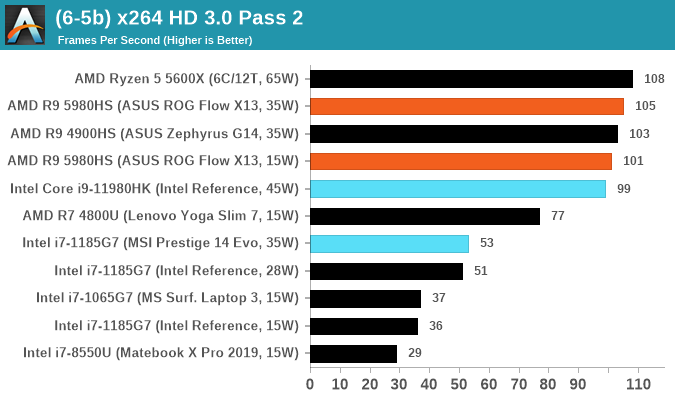
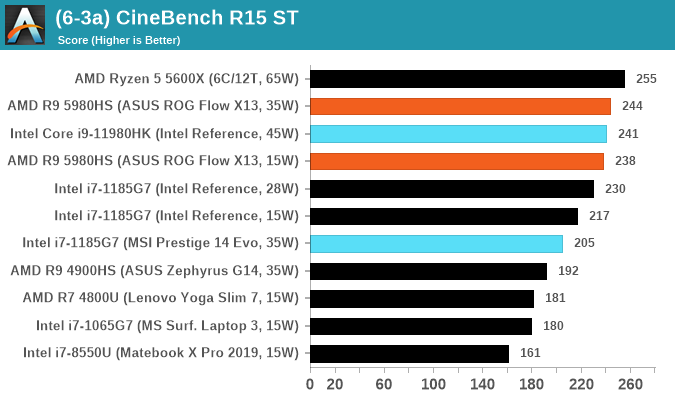
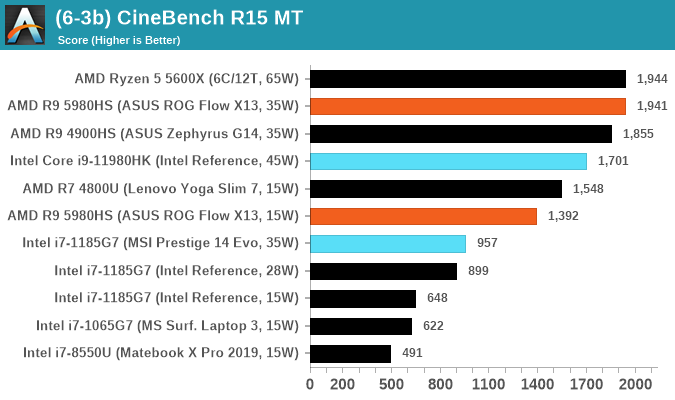


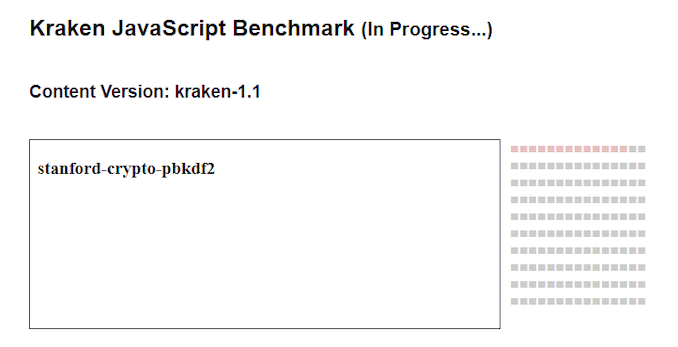
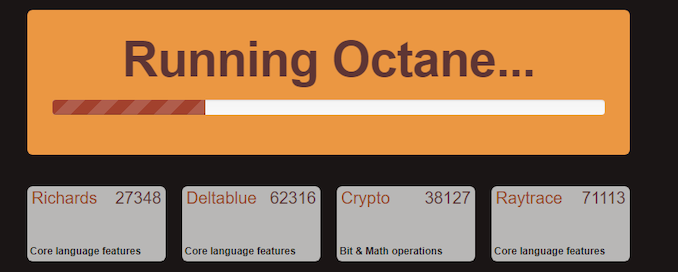









229 Comments
View All Comments
Bbdffd - Tuesday, May 18, 2021 - link
I think AMD still not able to defeat intel in Gaming even with their 7nm processor (5980hs).Cooe - Thursday, May 20, 2021 - link
"The performance lead against AMD’s strongest mobile CPU, the 5980HS"The 35W R9 5980HS is NOT AMD's strongest mobile CPU Brett. That would be the 45W unlocked & higher clocked R9 5980HX. I expect better from AnandTech... -_-
Spunjji - Thursday, May 20, 2021 - link
It is a little bit complicated... the 5900HX appears to beat the 5980HS by a little way in multi-thread tests but fall behind in single-thread, and if you look at things in performance-per-watt terms the 5980HS is easily the strongest. There's also the fact that there don't seem to be any shipping devices with the 5980HX in them. Strange times.ottonis - Friday, May 21, 2021 - link
So well, according to Intel's advertising materials, their new 11th gen Tiger Lake based 8c mobile CPUs were supposed to wipe the floor with AMD.Well... not really, according to this review, at least not within the same power consumption envelope and in multicore tasks.
block2 - Monday, May 24, 2021 - link
Running Intel at 35w if possible would be interesting.Unclear on quick read if external GPUs were disabled so that these tests aren't in reality a GPU test.
JayNor - Friday, May 28, 2021 - link
news out today in tomshardware that there is a B series of the 8 core TGL that boosts to 5.3GHz. This is even for parts with the GPU ...mode_13h - Saturday, May 29, 2021 - link
About right, for a desktop CPU.Makste - Monday, May 31, 2021 - link
This is a NUC part, not a laptop part.mode_13h - Tuesday, June 1, 2021 - link
Not really. NUCs normally use the U-series notebook CPUs. That's all a NUC is -- a notebook CPU in a compact enclosure.NUC Extreme is something completely different. They're more like a normal desktop PC, and the latest NUC Extreme that Intel just announced is the one that will use these H-series CPUs.